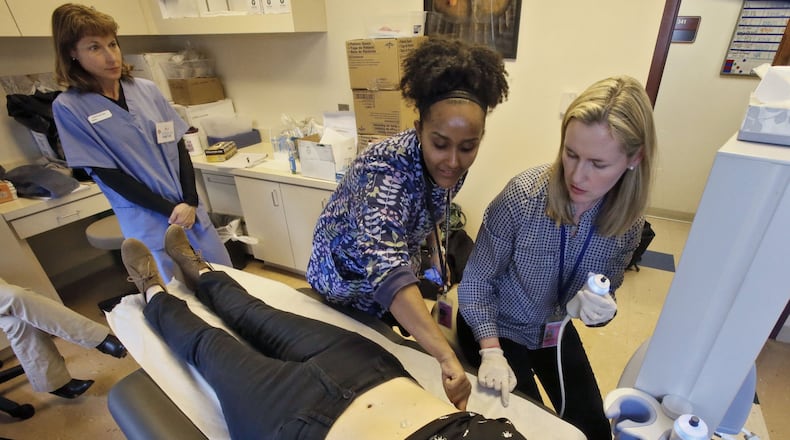The Trump administration announced major cuts to federal biomedical research funding beginning Monday that experts say threaten the viability of life-saving research and put at risk coveted knowledge jobs in Georgia.
The change is at the National Institutes of Health, the nation’s bedrock funder of research. Georgia universities, hospitals and businesses received more than $780 million in NIH support in the 12 months that ended in September.
The funding that research institutions and businesses across Georgia receive equals more than $2 billion a year in economic impact, according to one study, and it supports research that can lead to medicines and treatments that save and improve lives.
NIH grants also are key to training young scientists and are responsible for about 11,800 jobs in Georgia, according to the group United for Medical Research.
The administration targeted overhead costs in the announced cuts, saying administrative costs such as lab space, equipment and certain personnel expenses often were too high and now would be capped at 15% of the “direct” research costs in the grant. The cut was to be made immediately, including to projects already awarded and underway.
Recipients span the state, but by far Georgia’s largest is Emory University.
“These impacts are serious and may result in changes to many facets of work across Emory,” Emory health research leaders said in a statement to its community. They added that the institution was working over the weekend to respond to the developments.
Overhead funding “is essential to our research enterprise,” the statement said. “Every life-changing breakthrough we pursue — from cures for diseases to the discovery of new medicines — is made possible by the laboratory infrastructure, research security, information technology, and state-of-the-art equipment this (overhead) funding provides.”
Emory’s NIH funding in the last fiscal year totaled $488 million. Emory said it expected funding to decrease $140 million annually as a result of the change.
The NIH said in its order that universities take too much in overhead, and that private nonprofits often offer less.
The White House argued that it was not cutting “actual research” at all.
“The United States should have the best medical research in the world,” the NIH said in its order. “It is accordingly vital to ensure that as many funds as possible go towards direct scientific research costs rather than administrative overhead.”
Spokespeople for the University of Georgia, Georgia Tech and other state universities did not immediately reply to a request for comment this weekend.
The Morehouse School of Medicine said in a statement: “This decision will significantly impact medical research across the country, potentially limiting our ability to develop new treatments and innovations that benefit all Americans.”
The next-largest recipients in Georgia are the University of Georgia at $76 million, Augusta University at $73 million and Georgia Tech at $46 million.
NIH grants to the state over the past decade totaled more than $12 billion. Georgia leaders have leaned into the universities’ success and touted the supply of highly trained workers to biomedical companies.
The broader bioscience sector employed more than 40,000 people in Georgia in 2023, according to industry group Georgia Bio. The average wage for Georgia bioscience workers that year was more than $102,000, nearly 50% higher than the average private sector job in the state.
For the researchers losing funding, the potential loss of inventions and discovery by the U.S. was paramount.
“The development of new cancer drugs, of new antibiotics, of new antivirals, of new science that leads to better cures for diseases and better prevention — all that is going to slow down,” said Dr. Carlos del Rio, an Emory faculty leader, HIV researcher and NIH grant winner. “So, at the end of the day, the impact on the American public is significant. A clinical trial may not be conducted because there’s no resources to do it.”
Del Rio and others said the overhead was key to being able to run a scientific project, and in more expensive cities it’s naturally going to be higher. Reducing the amount would simply lead to fewer projects, he said.
“As a result of this, I think we’re no longer going to be the leader in biomedical research,” Del Rio said. “So who’s going to be the leader? China, probably. I’m sure China saw that news and said, ‘Yes, thank you very much.’”
The American Council on Education called the move a “self-inflicted wound.”
“This decision is short-sighted, naive, and dangerous,” the council said in a statement. “It will be celebrated wildly by our competitors, who will see this for what it is — a surrender of U.S. supremacy in medical research.”
A scientist at Yale University said the announcement signaled “a bloodbath” for science.
“This is not ‘trimming the fat.’” Dr. Perry Wilson, director of the Clinical and Translational Research Accelerator at Yale, wrote in a social media post. “This is cutting right to the bone. It will lead to mass layoffs at academic research centers,” and the abandoning of fundamental science that industry usually doesn’t fund because the return on investment isn’t immediately clear, he wrote.
The Association of American Medical Colleges said that “every American will be harmed.”
“The government’s support of facilities and administrative costs allows medical research to happen,” the Association said. “These real and documented research expenses include physical lab operations and maintenance, security, data processing and storage, and daily operations of critical research infrastructure. Make no mistake. This announcement will mean less research. Lights in labs nationwide will literally go out. Researchers and staff will lose their jobs.”
One lawmaker involved in health funding, U.S. Sen. Patty Murray, D-Washington, said a federal law prohibits modifications to NIH’s indirect costs, and that the move was illegal.
AJC digital storytelling editor Charles Minshew and newsroom data specialist Jennifer Peebles contributed to this story.
Keep Reading
The Latest
Featured





